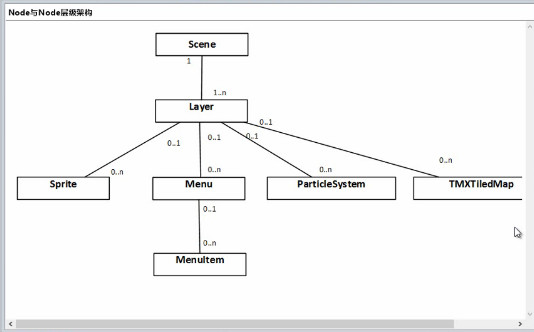Node之间的关系:

场景AppDelegate.cpp又要由导演去调用然后进行表演:
// create a scene. it's an autorelease object auto scene = HelloWorld::createScene(); // run director->runWithScene(scene);
这里层里面的场景HelloWorldScene.cpp里面的内容:
#include "HelloWorldScene.h" USING_NS_CC; Scene* HelloWorld::createScene() { // 'scene' is an autorelease object auto scene = Scene::create(); // 'layer' is an autorelease object auto layer = HelloWorld::create(); // add layer as a child to scene scene->addChild(layer); // return the scene return scene; } // on "init" you need to initialize your instance bool HelloWorld::init() { ////////////////////////////// // 1. super init first if ( !Layer::init() ) { return false; } Size visibleSize = Director::getInstance()->getVisibleSize(); Vec2 origin = Director::getInstance()->getVisibleOrigin(); ///////////////////////////// // 2. add a menu item with "X" image, which is clicked to quit the program // you may modify it. //每一个addChild会创建出一个添加的层 // add a "close" icon to exit the progress. it's an autorelease object auto closeItem = MenuItemImage::create( "CloseNormal.png", "CloseSelected.png", CC_CALLBACK_1(HelloWorld::menuCloseCallback, this)); closeItem->setPosition(Vec2(origin.x + visibleSize.width - closeItem->getContentSize().width/2 , origin.y + closeItem->getContentSize().height/2)); // create menu, it's an autorelease object auto menu = Menu::create(closeItem, NULL); menu->setPosition(Vec2::ZERO); this->addChild(menu, 1); ///////////////////////////// // 3. add your codes below... // add a label shows "Hello World" // create and initialize a label auto label = Label::createWithTTF("Hello sunzhiyan", "fonts/arial.ttf", 24); // position the label on the center of the screen label->setPosition(Vec2(origin.x + visibleSize.width/2, origin.y + visibleSize.height - label->getContentSize().height)); // add the label as a child to this layer this->addChild(label, 1); auto label1= Label::createWithTTF("88888888888888", "fonts/arial.ttf", 40); // position the label on the center of the screen label1->setPosition(Vec2(origin.x + visibleSize.width / 3, origin.y + visibleSize.height - label1->getContentSize().height)); // add the label as a child to this layer this->addChild(label1, 1); //创建一个精灵 auto sprite = Sprite::create("sun.jpg"); //设置精灵的显示位置 sprite->setPosition(Vec2(visibleSize.width/2 + origin.x, visibleSize.height/2 + origin.y)); // 将精灵添加到层里面 this->addChild(sprite, 0); return true; } void HelloWorld::menuCloseCallback(Ref* pSender) { Director::getInstance()->end(); #if (CC_TARGET_PLATFORM == CC_PLATFORM_IOS) exit(0); #endif }